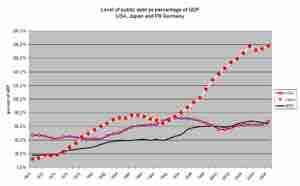Government debt is the debt owed by a central government. In the United States and other federal states, government debt may also refer to the debt of a state or provincial government, municipal or local government. By contrast, the annual government deficit refers to the difference between government receipts and government spending in a single year, that is, the increase in debt over a particular year. Government debt is one method of financing government operations, but it is not the only method. Governments can also create money to monetize their debts, thereby eliminating the need to pay interest. Doing this, however, simply reduces government interest costs, rather than truly fixing the government debt. Governments usually borrow by issuing securities, government bonds, and bills. Less creditworthy countries sometimes borrow directly from a supranational organization, like the World Bank, or international financial institutions.

Public Debt
National Debt Clock outside the IRS office in NYC, July 1, 2010.
Because the government draws its income from much of the population, government debt is an indirect debt of the taxpayers. Government debt can be categorized as internal debt (owed to lenders within the country) and external debt (owed to foreign lenders). Sovereign debt usually refers to government debt that has been issued in a foreign currency. Government debt can also be categorized by duration until repayment is due. For instance, short term debt is generally considered to last for one year or less, while long term debt is for more than ten years. Medium term debt falls between these two boundaries. A broader definition of government debt may consider all government liabilities, including future pension payments and payments for goods and services the government has contracted, but not yet paid.
Government deficit, on the other hand, refers to a situation when the government's expenses, including its purchases of goods and services, its transfers (grants) to individuals and corporations, and its net interest payments, exceed its tax revenues. Deficit spending occurs when government spending exceeds tax receipts. Governments usually issue bonds to match their deficits. Bonds can be bought by the Central Bank through quantitative easing. Otherwise the debt issuance can increase the level of (i) public debt, (ii) private sector net worth, (iii) debt service (interest payments) and (iv) interest rates. Deficit spending may, however, be consistent with public debt, remaining stable as a proportion of GDP, depending on the level of GDP growth.

Public Debt as a Percentage of GDP
General government debt as a percent of GDP in USA, Japan, and Germany.
Deficit Reduction Debate: Differences between the two Parties
In the United States, taxes are imposed on net income of individuals and corporations by the federal, most state, and some local governments. One of the largest budget expenditures for state governments is Medicaid. The United States public debt is the outstanding amount owed by the federal government of the United States from the issue of securities by the Treasury and other federal government agencies. US public debt consists of two components:
- Debt held by the public includes Treasury securities held by investors outside the federal government, including that held by individuals, corporations, the Federal Reserve System and foreign, state and local governments.
- Debt held by government accounts or intragovernmental debt includes non-marketable Treasury securities held in accounts administered by the federal government that are owed to program beneficiaries, such as the Social Security Trust Fund. Debt held by government accounts represents the cumulative surpluses, including interest earnings, of these accounts that have been invested in Treasury securities.
Democrats and Republicans mean very different things when they talk about tax reform. Democrats argue for the wealthy to pay more via higher income tax rates, while Republicans focus on lowering income tax rates. While both parties discuss reducing tax expenditures (i.e., exemptions and deductions), Republicans focus on preserving lower tax rates for capital gains and dividends, while Democrats prefer educational credits and capping deductions. Political realities make it unlikely that more than $150 billion per year in individual tax expenditures could be eliminated. One area with more common ground is corporate tax rates, where both parties have generally agreed that lower rates and fewer tax expenditures would align the U.S. more directly with foreign competitioIn addition to policies regarding revenue and spending, policies that encourage economic growth are the third major way to reduce deficits. Economic growth offers the "win-win" scenario of higher employment, which increases tax revenue while reducing safety net expenditures for such things as unemployment compensation and food stamps. Other deficit proposals related to spending or revenue tend to take money or benefits from one constituency and give it to others, a "win-lose" scenario. Democrats typically advocate Keynesian economics, which involves additional government spending during an economic downturn. Republicans typically advocate Supply-side economics, which involves tax cuts and deregulation to encourage the private sector to increase its spending and investment.